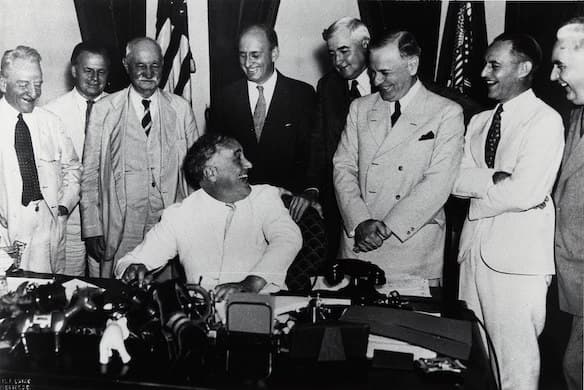Franklin Delano Roosevelt, in a New Biography, Is Captured by Indirection
David Pietrusza masterfully ties together the different personalities and parties surrounding the president, while Roosevelt himself appears in cameos as an opportunist looking to see what works.

‘Roosevelt Sweeps Nation: FDR’s Landslide and the Triumph of the Liberal Ideal’
By David Pietrusza
Diversion Books (544 pages)
How can one write history so that it seems like a thriller? How does one write a biography without making the subject the centerpiece of the narrative? I have no idea if David Pietrusza asked himself these questions — or this one: How can history be written as a newspaper headline?
Call this a biography by indirection. Franklin Delano Roosevelt is defined by competing individuals and movements: Huey Long, Father Coughlan, Al Smith, the Liberty League, Earl Browder and the Communist Party, Dr. Francis Townsend and the Townsend Plan, Norman Thomas and the Socialist Party. They threatened FDR’s majority in the 1936 election.
By 1935, pundits and polls suggested that the New Deal had stalled. Government spending had not lifted the nation out of the Depression. Smith, a Democratic presidential candidate in 1928 and former governor of New York, had soured on FDR. Initial support from Coughlan, the radio priest, had turned to vicious opposition.
Like Coughlan, Long, who was popular in Louisiana and in nationwide Share the Wealth Clubs, made New Deal promises of a better life seem all too modest, especially when compared to the Townsend Plan that proposed something like a universal basic income.
Browder’s Communist Party, with its popular front strategy of supporting FDR, put Roosevelt in the uncomfortable position of having supporters he had to disown without alienating liberal allies, some of whom signed on to the Communist Party’s social justice positions.
Disaffections from New Deal orthodoxy also fueled members of the Liberty League, a confusing conglomeration of liberals and conservatives uncomfortable with FDR’s big-government policies and, in their view, dictatorial tendencies. FDR intensified their opposition with fierce attacks on big business widely interpreted as class warfare.
Mr. Pietrusza masterfully ties together these different personalities and parties. Roosevelt himself appears in cameos as an opportunist looking to see what works and trying to at least mitigate the impact of figures like Coughlan and Long by speaking their language and co-opting some of their programs.
Polls showed a likely presidential candidate, Governor Alf Landon of Kansas, way ahead of FDR — but much of that support, FDR seems to have realized, was soft. Landon, not so different from FDR in terms of policies, promised that he could deliver the goods, so to speak, more efficiently: a business-like New Deal.
Not until the beginning of the 1936 campaign did it become apparent that the odds had shifted in FDR’s favor. Landon proved to be an uninspiring speaker and listless campaigner. And yet, as Mr. Pietrusza shows, bets were still placed on Landon and lots of people made money by backing what was still considered a risky Roosevelt.
What happened? Not every successful presidential candidate has been a good speaker, or even especially energetic. This is where Mr. Pietrusza’s subtitle comes into the play. The country — at least more than enough of it — had been persuaded by the liberal ideal. For the first time, African Americans found employment in federal programs, and the poor and other working Americans would receive relief in the Social Security Act passed in 1935.
Many Republicans supported the Social Security Act, but to other conservatives, FDR had put part of the nation on the payroll. Voters saw the tangible benefits of New Deal programs, and so favored FDR even as they told pollsters they were not expecting more radical innovations from a Democratic presidency.
Mr. Pietrusza makes all this history come alive by treating it rather like reading newspapers of those years, as various figures move up and down in the public’s estimation, while Roosevelt bides his time, never panicking and believing in his own genius — which is often shown in unflattering scenes revealing his sarcastic brilliance.
It could have turned out differently, Mr. Pietrusza implies. What if Huey Long had not been assassinated? What if Father Coughlan had tempered his more outrageous attacks? What if Francis Townsend had been able to explain how his universal basic income could be paid for?
The canny Roosevelt watched and waited for these contenders to fail, and what resulted was a victory that kept the Democratic Party in power for several more generations.
Mr. Rollyson is the author of “Beautiful Exile: The Life of Martha Gellhorn,” who worked in FDR’s Federal Emergency Relief Administration.

